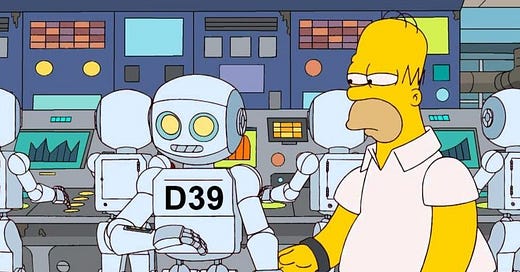🤖 The case against mass technological unemployment. (And what happens if I’m wrong.)
Also: 5 Quick Questions for ... Caltech's Ali Hajimiri on the future of space-based solar power
In This Issue
The Essay: The end of the Age of Labor? The case against mass technological unemployment. (And what happens if I’m wrong.)
5QQ: 5 Quick Questions for ... Caltech's Ali Hajimiri on the future of space-based solar power
Micro Reads: a new AI approach, Alzheimer’s cure conundrum, manufacturing with people, and more …
Quote of the Issue
"The dots to which our energy beams are directed are nearer and much smaller. They are cold and hard and human beings like myself live upon their surfaces — many billions of them. … Our beams feed these worlds energy drawn from one of those huge incandescent globes that happens to be near us. We call that globe the Sun …” - Isaac Asimov, “Reason,” 1941
The Essay
🤖 The end of the Age of Labor? The case against mass technological unemployment. (And what happens if I’m wrong.)
If you had cooked up a scenario back in 2019 — when the jobless rate was at a 50-year low — that a year later unemployment would reach its highest levels since the Great Depression, at least a few people might have asked, “What, did the robots finally take all the jobs?” Indeed, there was plenty of concern about technological unemployment in the years leading up to the COVID-19 pandemic. Now as the threat from the outbreak has receded and worker shortages persist, automation worriers can be forgiven for again wondering about a jobless future. A few recent and relevant headlines:
“Meet DALL-E, the A.I. That Draws Anything at Your Command” - NYT
“Google Suspends Engineer Who Claimed AI Bot Had Become Sentient” - Bloomberg
“Google CFO: Anything That Can Be Automated, We Strive to Automate” - WSJ
“Robots Pick Up More Work at Busy Factories” - WSJ
“Robot sales hit record high in first quarter of 2022”- The Robot Report
“Amazon unveils a new fleet of robots and automated systems” - GeekWire
How should future-oriented countries and policymakers — workers, as well — think today about the nature of a possible post-work world tomorrow? Plenty of valuable insights can be found in the excellent new NBER working paper “Preparing for the (Non-Existent?) Future of Work” by economist Anton Korinek and researcher Megan Juelfs, both of the University of Virginia. Korinek and Juelfs consider “the labor market and distributional implications of a scenario of ever-more intelligent autonomous machines that substitute for human labor and drive down wages.” More specifically, they examine “machine intelligence and AI-powered robots that can perform both “non-routine manual tasks and … higher-order cognitive tasks that require an understanding of the world, planning, and crucially, social intelligence.”
In other words, we’re talking about a future where supersmart technology potentially makes a large number of human workers redundant. Maybe almost all of us.
Such an automation scenario suggests three reasonable concerns, as outlined by Korinek and Juelfs:
Keep reading with a 7-day free trial
Subscribe to Faster, Please! to keep reading this post and get 7 days of free access to the full post archives.




